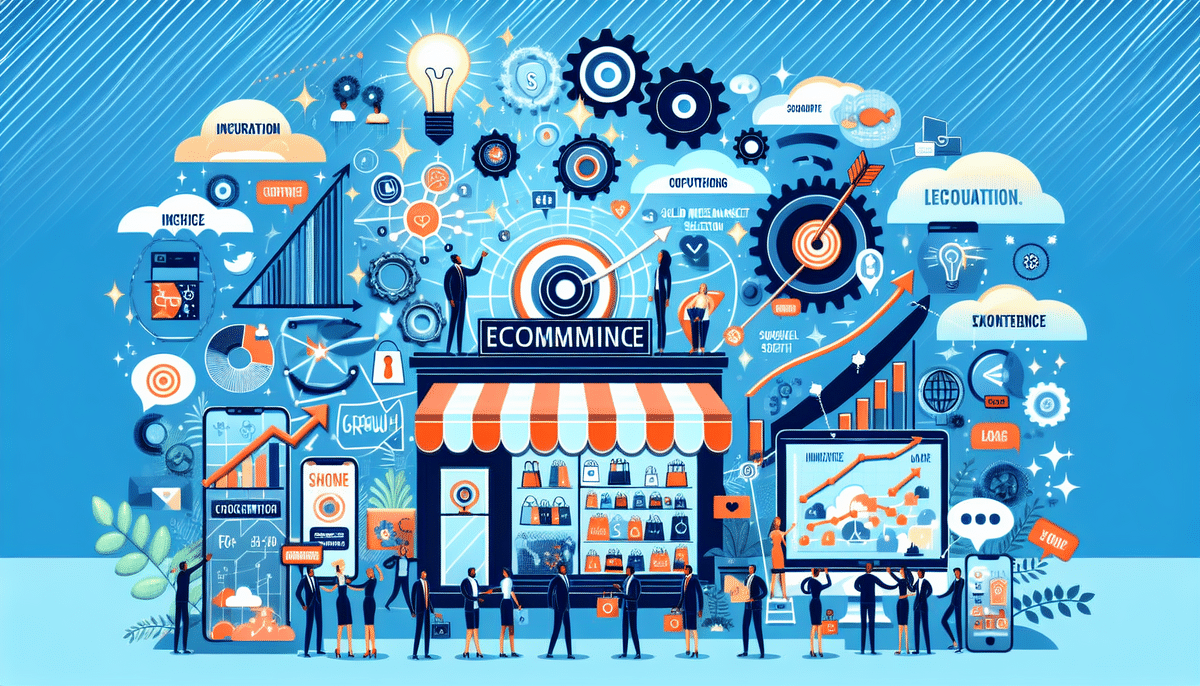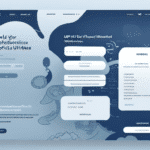Scaling Your Ecommerce Business: Strategies for Success
Scaling your ecommerce business is a common aspiration among entrepreneurs, but achieving sustainable growth requires strategic planning and execution. In this comprehensive guide, we'll explore proven strategies to help you elevate your ecommerce venture to the next level. From meticulous planning to leveraging cutting-edge technology, these insights will equip you with the tools needed for long-term success.
The Importance of Planning and Goal-Setting
Effective scaling begins with setting clear, measurable goals and developing a strategic plan to achieve them. According to a U.S. Small Business Administration report, businesses with defined goals are 10 times more likely to achieve sustained growth.
- Short-Term Goals: Focus on immediate objectives like increasing website traffic or improving customer service.
- Long-Term Goals: Aim for broader ambitions such as expanding into new markets or diversifying your product line.
Regularly tracking your progress through key performance indicators (KPIs) ensures that you stay aligned with your objectives and can make informed adjustments as needed.
Identifying Your Niche Market
Understanding your target audience is crucial for effective scaling. A well-defined niche allows you to tailor your marketing efforts and product offerings to meet specific customer needs. Shopify reports that niche markets often have higher conversion rates due to their targeted approach.
- Conduct Market Research: Utilize tools like Google Analytics and surveys to gather data on consumer behavior and preferences.
- Analyze Competitors: Identify gaps in the market by examining what competitors offer and where they fall short.
- Engage with Customers: Collect feedback directly from your customer base to understand their pain points and desires.
By deeply understanding your niche, you can create more personalized marketing campaigns and foster stronger customer loyalty.
Developing a Strong Brand Identity
A compelling brand identity differentiates your ecommerce business in a crowded marketplace. It encompasses your brand's values, personality, and unique selling propositions (USPs). According to a Millward Brown study, consistent brand presentation can increase revenue by up to 33%.
- Visual Consistency: Maintain uniformity in colors, fonts, and imagery across all platforms, including your website and social media.
- Consistent Messaging: Ensure that your brand voice aligns with your values and resonates with your target audience.
- Brand Storytelling: Share your brand's story to create an emotional connection with customers.
A strong brand not only enhances recognition but also builds trust, encouraging repeat business and referrals.
Creating an Effective Marketing Plan
An integrated marketing plan is essential for scaling your ecommerce business. It should encompass various channels and strategies to maximize reach and engagement.
Key Components of a Marketing Plan
- Content Marketing: Develop high-quality content that provides value to your audience and positions your brand as an authority.
- Social Media Marketing: Utilize platforms where your target audience is most active to build brand awareness and drive traffic.
- Email Marketing: Implement personalized email campaigns to nurture leads and retain existing customers.
- Paid Advertising: Invest in PPC campaigns, social media ads, and influencer partnerships to expand your reach.
Monitoring and analyzing the performance of each marketing channel allows you to allocate resources effectively and optimize your strategies for better results.
Streamlining Your Operations for Efficiency
Operational efficiency is critical for handling increased order volumes without compromising quality. Automating repetitive tasks and optimizing workflows can significantly enhance productivity.
Implementing a reliable inventory management system is a pivotal step in this process. Such systems help in tracking stock levels, forecasting demand, and managing reorder points, reducing the risk of stockouts and overstocking.
- Automate Order Processing: Use software to handle order confirmations, invoicing, and shipping notifications.
- Outsource Non-Core Activities: Delegate tasks like customer support or fulfillment to specialized services.
- Optimize Supply Chain: Streamline relationships with suppliers to ensure timely deliveries and favorable terms.
Enhancing operational efficiency not only reduces costs but also improves customer satisfaction by ensuring timely and accurate order fulfillment.
Managing Inventory and Fulfillment
As your ecommerce business scales, effective inventory management and fulfillment processes become increasingly complex. Efficient management ensures that you can meet customer demand without overextending resources.
Utilize advanced inventory management software to gain real-time visibility into your stock levels, automate reorder points, and analyze sales trends. Tools like TradeGecko or Shopify Inventory offer comprehensive solutions for managing inventory seamlessly.
- Set Reorder Points: Determine optimal stock levels to trigger automatic reordering before inventory runs low.
- Analyze Sales Data: Use historical sales data to forecast future demand and adjust inventory accordingly.
- Optimize Fulfillment Processes: Implement efficient picking and packing strategies to accelerate order processing.
Additionally, partnering with reliable shipping carriers and offering multiple shipping options can enhance your fulfillment capabilities, ensuring orders are delivered promptly and accurately.
Expanding Your Product Line
Diversifying your product offerings can attract a broader customer base and increase revenue streams. However, strategic expansion is crucial to maintain brand coherence and meet market demand.
- Market Research: Identify gaps in the market and understand customer needs to inform your product expansion.
- Supplier Relationships: Ensure you have reliable suppliers to support new product lines without compromising quality.
- Inventory Management: Adjust your inventory strategies to accommodate new products, avoiding overstocking or stockouts.
For example, introducing complementary products can enhance the customer experience and encourage repeat purchases, fostering long-term loyalty.
Building a Strong Customer Base through Exceptional Service
Exceptional customer service is a cornerstone of sustainable growth. Providing prompt, personalized, and effective support can significantly enhance customer satisfaction and loyalty.
- Responsive Support: Utilize live chat, email, and phone support to address customer inquiries swiftly.
- Personalization: Leverage customer data to offer personalized recommendations and tailored experiences.
- Feedback Mechanisms: Implement systems for collecting and acting on customer feedback to continuously improve your offerings.
According to a Forbes article, businesses that prioritize customer service can achieve higher retention rates and generate positive word-of-mouth referrals, driving organic growth.
Leveraging Technology to Drive Growth
Embracing the latest technology can streamline your operations, enhance the customer experience, and provide valuable insights for decision-making.
- Automation Tools: Automate tasks such as email marketing, social media posting, and inventory management to save time and reduce errors.
- Analytics Platforms: Use tools like Google Analytics or Tableau to gain insights into customer behavior and sales trends.
- Personalization Engines: Implement technologies that customize the shopping experience based on individual customer preferences.
Investing in AI-driven chatbots can also enhance customer support by providing instant responses and handling common inquiries, improving overall satisfaction.
Optimizing Your Website for Increased Traffic and Conversions
Your website serves as the primary touchpoint for customers, making its optimization critical for driving traffic and converting visitors into buyers.
- SEO Optimization: Enhance your website’s visibility on search engines by using relevant keywords, optimizing meta tags, and creating high-quality content.
- User Experience (UX): Ensure your site is easy to navigate, mobile-friendly, and has fast loading times to reduce bounce rates.
- Conversion Rate Optimization (CRO): Implement strategies such as A/B testing, clear call-to-actions, and streamlined checkout processes to boost conversions.
According to Search Engine Journal, businesses that invest in SEO can experience a significant increase in organic traffic, leading to higher sales and revenue.
Utilizing Social Media to Expand Your Reach
Social media platforms offer unparalleled opportunities to connect with your audience, build brand awareness, and drive traffic to your ecommerce site.
- Platform Selection: Choose social media platforms that align with your target audience’s preferences, such as Instagram for visual products or LinkedIn for B2B services.
- Content Strategy: Share a mix of promotional content, user-generated content, and engaging posts to keep your audience interested.
- Social Media Advertising: Invest in targeted ads to reach a broader audience and drive specific actions, such as website visits or sales.
Leveraging influencers can also amplify your reach. Partnering with influencers who resonate with your brand can introduce your products to their engaged followers, fostering trust and credibility.
Measuring Success: Key Metrics to Track
Tracking and analyzing key metrics is essential for assessing the effectiveness of your scaling strategies and making data-driven decisions.
- Conversion Rate: The percentage of visitors who make a purchase, indicating the effectiveness of your sales funnel.
- Average Order Value (AOV): The average amount spent per transaction, helping you understand customer spending behavior.
- Customer Retention Rate: Measures the percentage of customers who return to make additional purchases.
- Customer Acquisition Cost (CAC): The cost associated with acquiring a new customer, essential for evaluating marketing efficiency.
- Lifetime Value (LTV): The total revenue a customer is expected to generate over their relationship with your business.
Utilizing analytics tools like Google Analytics and ecommerce platforms’ built-in reporting features can provide valuable insights into these metrics, enabling you to refine your strategies for optimal performance.
Staying Ahead of the Competition with Innovation
The ecommerce landscape is continually evolving, making innovation a key driver of sustained growth. Staying ahead of trends and adopting new technologies can give you a competitive edge.
- Product Innovation: Regularly update and expand your product offerings to meet changing customer needs.
- Technology Adoption: Implement the latest tools and platforms to enhance operational efficiency and customer experience.
- Market Trends: Stay informed about industry trends through resources like Forbes Ecommerce and Shopify Blogs.
Investing in research and development (R&D) can lead to the creation of innovative products or the improvement of existing ones, positioning your brand as a leader in your niche.
Collaborating with Influencers and Partners
Strategic collaborations with influencers and business partners can significantly expand your brand’s reach and credibility.
- Influencer Marketing: Partner with influencers who align with your brand values to promote your products to their engaged audiences.
- Strategic Partnerships: Collaborate with complementary businesses to co-create products, bundle offerings, or cross-promote services.
- Affiliate Programs: Establish affiliate partnerships to incentivize others to promote your products in exchange for a commission.
According to a Statista report, influencer marketing is projected to become a $15 billion industry by 2022, highlighting its growing importance in ecommerce strategies.
Financing Growth: Options for Funding Your Expansion
Securing adequate funding is essential for scaling your ecommerce business. Various financing options cater to different business needs and growth stages.
- Traditional Bank Loans: Offer relatively low-interest rates but require solid credit history and collateral.
- Venture Capital: Suitable for high-growth startups seeking substantial investment in exchange for equity.
- Crowdfunding: Platforms like Kickstarter and Indiegogo allow you to raise funds from a large pool of individual backers.
- Angel Investors: Provide capital in exchange for ownership equity or convertible debt.
- Bootstrapping: Self-funding through personal savings or reinvested profits, offering complete control but limited scalability.
Evaluate each option’s pros and cons to determine the best fit for your business’s financial needs and growth objectives.
Hiring and Managing a Team to Support Your Growth
As your ecommerce business expands, building a competent and motivated team is crucial for maintaining operational efficiency and driving growth.
- Recruitment: Define clear role requirements and use platforms like LinkedIn or Indeed to attract qualified candidates.
- Training and Development: Invest in ongoing training programs to enhance your team’s skills and keep them updated with industry trends.
- Communication Protocols: Establish effective communication channels and regular check-ins to ensure team alignment and collaboration.
- Performance Management: Implement performance metrics and feedback systems to monitor progress and foster accountability.
According to the Gallup report, engaged teams are 21% more productive, underscoring the importance of effective team management in business growth.
Preparing for the Future: Long-Term Planning Strategies
Long-term planning ensures that your ecommerce business remains resilient and adaptable in the face of evolving market conditions and future challenges.
- Market Research: Continuously analyze market trends and consumer behavior to anticipate changes and adjust strategies accordingly.
- Contingency Planning: Develop plans to address potential risks such as supply chain disruptions, economic downturns, or technological changes.
- Scalability: Design your business processes and infrastructure to accommodate future growth without significant overhauls.
- Sustainability: Incorporate sustainable practices to meet consumer demand for environmentally responsible businesses and ensure long-term viability.
By prioritizing long-term planning, you can position your ecommerce business to capitalize on opportunities and navigate challenges effectively, ensuring sustained growth and success.
Implementing these strategies will place your ecommerce business on a path to scalable and sustainable growth. With dedication, strategic planning, and a focus on continuous improvement, you can transform your vision into a thriving reality that meets and exceeds customer expectations.






















